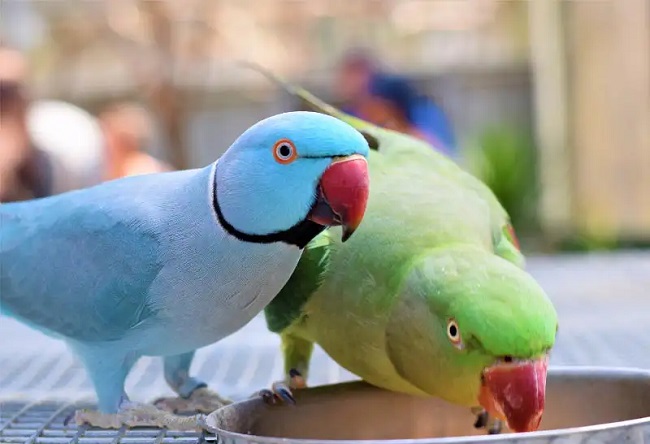The Blue Indian Ringneck Parakeet, a variant of the Indian Ringneck Parakeet, captures hearts with its vibrant plumage and engaging personality.
If you’re a bird enthusiast seeking comprehensive knowledge about this bird, we’ve got you covered. In this article, we’ll explore the traits, history, diet, and care of this mesmerizing parrot species.

The Striking Traits of the Blue Indian Ringneck Parakeet
Blue Indian Ringneck Parakeets are medium-sized birds with a remarkable blue-grey plumage that truly sets them apart. Their name originates from the black ring around the neck of males, a feature that females lack.
Read Also:
Notably, these parrots have a relatively long lifespan of up to 30 years and are known for their ability to mimic human speech.
The Fascinating History of the Blue Indian Ringneck Parakeet
Indian Ringneck Parakeets, including their blue variant, have a rich history dating back thousands of years.
Native to India and parts of Asia, these birds were kept as pets by nobility and have been noted in Indian and Greek historical writings. Today, they’re adored globally for their vibrant color, intellect, and playful nature.
What Does a Blue Indian Ringneck Parakeet Eat?
Like other parrots, the Blue Indian Ringneck Parakeet thrives on a varied diet. Fresh fruits and vegetables, seeds, and specialized parakeet pellets should constitute their daily meals. Avoid avocados and chocolate as these foods can be toxic to birds.
Care for Your Blue Indian Ringneck Parakeet
Caring for a Blue Indian Ringneck Parakeet requires dedication and knowledge. Here are the essential aspects of their care:
Environment: Provide a spacious cage with plenty of room to move and play. Include perches and toys for mental and physical stimulation.
Social Interaction: These parakeets are social birds. They require daily interaction and stimulation to remain happy and healthy.
Grooming: Regular baths or misting helps keep their feathers in top condition.
Healthcare: Regular vet checks are necessary to ensure your parakeet stays in good health. Monitor for any changes in behavior or physical appearance.
Training Your Blue Indian Ringneck Parakeet
One of the standout traits of the Blue Indian Ringneck Parakeet is its intelligence, which allows it to learn and mimic human speech and perform tricks. However, training these birds requires patience and consistency.
Step-by-step Training
Start by acclimating your parakeet to your presence. Spend time around their cage, talking and singing to them softly. Once they’re comfortable with you, you can begin training.
Use treats as a positive reinforcement during training. Fruits like apples or berries can make good rewards.
Keep your training sessions short, about 10-15 minutes each, to prevent your bird from becoming overwhelmed. Remember, patience and consistency are key!
The Right Toys for Your Blue Indian Ringneck Parakeet
Blue Indian Ringneck Parakeets are active and playful birds. Providing the right toys will keep them entertained and mentally stimulated. Toys should be safe, non-toxic, and durable.
Puzzle Toys: These engage their intellect and can keep them occupied for hours.
Foraging Toys: These allow your parakeet to ‘hunt’ for their food, stimulating their natural foraging behavior.
Mirrors: Many parakeets enjoy interacting with their reflections, making mirrors an entertaining addition to their cage.
Breeding Blue Indian Ringneck Parakeets
Breeding these parakeets requires a comprehensive understanding of their needs. A breeding pair requires a large cage or aviary, a balanced diet, and a suitable nesting box.
Breeding typically occurs in the spring, and the female will lay 4-6 eggs on average, which she will incubate for about 23 days.
Importance of Health Check-ups for Your Blue Indian Ringneck Parakeet
Regular health check-ups with a qualified avian vet are crucial for maintaining your parakeet’s health. These can help detect any potential health issues early and ensure your parakeet stays in good condition.
Be vigilant for signs of illness, such as changes in appetite, lethargy, or changes in droppings.
Read Also:
Conclusion
The Blue Indian Ringneck Parakeet is a remarkable bird, adored for its stunning color, rich history, and playful, intelligent nature. Owning one can be a rewarding experience.
However, it is a commitment that requires a deep understanding of their dietary needs, social requirements, and overall care. With the right environment and care, your parakeet can live a healthy, long, and happy life.
























